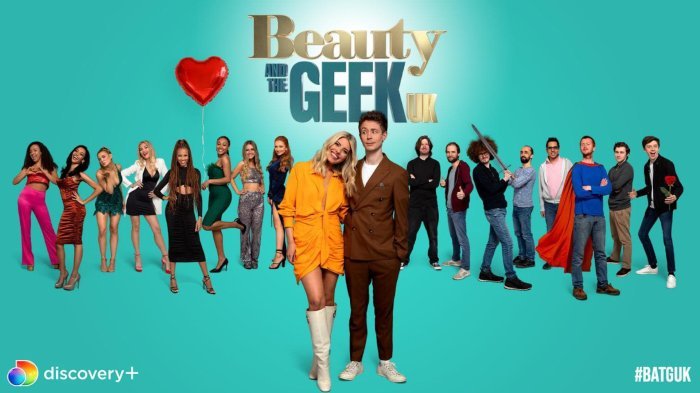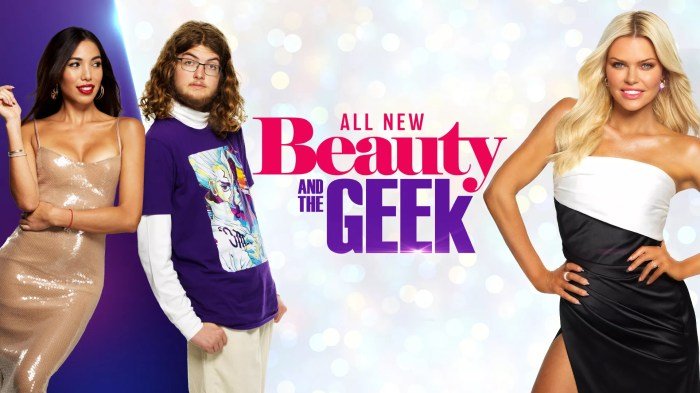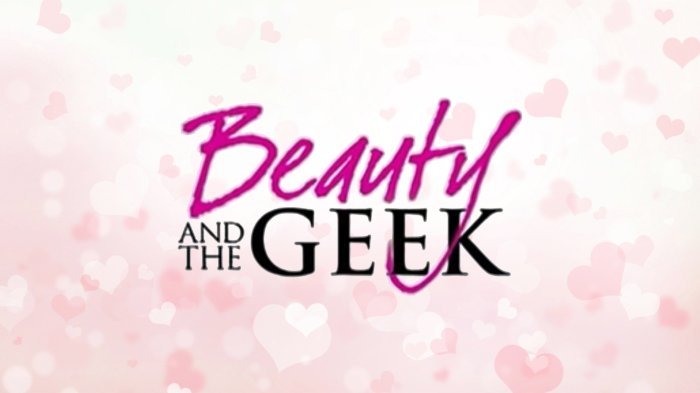The beauty and the geek, two seemingly opposing archetypes, have long captivated our imaginations. From classic literature to modern media, these figures have shaped our perceptions of what it means to be attractive and intelligent. But in a world increasingly defined by diversity and inclusivity, the lines between beauty and geekiness are blurring, revealing a more nuanced and complex relationship between these seemingly disparate concepts.
This exploration delves into the historical evolution of beauty and geek stereotypes, examining how these perceptions have shifted across cultures and generations. We’ll analyze how popular media has portrayed these archetypes, showcasing both the enduring power of stereotypes and the emergence of new, more inclusive narratives.
By exploring the intersection of beauty and geekiness, we’ll uncover how these seemingly contradictory qualities can coexist and even complement each other, challenging the traditional dichotomy and celebrating the beauty of diversity.
The Concept of Beauty and Geek

The terms “beauty” and “geek” have long been used to categorize individuals based on perceived social norms and cultural values. These terms have evolved over time, reflecting changing societal expectations and the influence of various social forces. Examining the historical and cultural context of these terms provides insights into the evolving nature of societal perceptions.
Historical and Cultural Evolution of Beauty and Geek Stereotypes
The concept of beauty has been shaped by historical and cultural factors. In ancient civilizations, beauty standards often reflected ideals of health, fertility, and social status. For example, in ancient Greece, physical perfection was highly valued, with sculptures and paintings depicting idealized forms of the human body.
In medieval Europe, beauty standards shifted towards a more idealized and ethereal look, with pale skin, delicate features, and long, flowing hair being considered desirable.The term “geek” emerged in the late 19th century and originally referred to carnival performers who displayed unusual or bizarre acts.
In the early 20th century, the term “geek” began to be associated with individuals who were considered intellectually or socially awkward. This perception was often fueled by popular culture, with movies and television shows portraying geeks as unfashionable, introverted, and lacking in social skills.
Traditional Perceptions of Beauty and Geekiness Across Societies
Traditional perceptions of beauty and geekiness vary significantly across different societies. In some cultures, beauty standards emphasize physical attributes such as skin tone, body shape, and hair texture. In other cultures, beauty may be defined by a combination of physical attributes and personality traits, such as intelligence, kindness, and humor.Similarly, the perception of geekiness can vary across cultures.
In some societies, individuals who are passionate about technology, science, or literature are considered to be geeks. In other societies, geekiness may be associated with a lack of social skills or a preference for solitary activities.
Changing Social Landscape and Perceptions of Beauty and Geekiness
The social landscape is constantly changing, and this has a significant impact on perceptions of beauty and geekiness. The rise of social media and online communities has led to a greater diversity of beauty standards and a broader acceptance of different types of geekiness.
For example, social media platforms have allowed individuals to challenge traditional beauty norms and promote body positivity. Online communities have provided a space for individuals who share similar interests, regardless of their perceived social status or physical appearance.
- The growing influence of technology has also contributed to a shift in perceptions of geekiness. Individuals who are skilled in technology or science are increasingly valued in society.
- The rise of e-sports and gaming has also led to a greater acceptance of geek culture.
In conclusion, the concepts of beauty and geekiness are fluid and constantly evolving. As society continues to change, so too will our perceptions of these terms.
The Beauty and the Geek in Popular Culture

The portrayal of beauty and geekiness in popular culture has evolved significantly over time, reflecting changing societal norms and perceptions. From classic literature to modern-day movies and television shows, these archetypes have become ingrained in our collective consciousness, influencing how we view ourselves and others.
Iconic Characters and Their Impact
The “beauty” and “geek” archetypes have been embodied by countless characters in popular media, shaping our understanding of these concepts and their associated traits.
- Beauty:The “beauty” archetype is often depicted as physically attractive, charming, and socially adept. Iconic examples include Scarlett O’Hara from Gone with the Wind, who is known for her beauty and charisma, and Marilyn Monroe, whose image became synonymous with Hollywood glamour.
The Beauty and the Geek, a show that celebrates individuality, highlights the importance of finding a balance between inner and outer beauty. It’s a reminder that true confidence comes from within. Princeton Fitness and Wellness, a premier fitness center , emphasizes this holistic approach by offering programs that cater to both physical and mental well-being.
Ultimately, the show and the center share a common goal: empowering individuals to embrace their unique qualities and strive for a fulfilling life.
These characters often represent the ideal of femininity and are associated with desirability, success, and popularity.
- Geek:The “geek” archetype, on the other hand, is often portrayed as intellectually gifted, socially awkward, and passionate about their interests. Examples include Hermione Granger from the Harry Potterseries, who excels academically and possesses a vast knowledge of magic, and Sheldon Cooper from The Big Bang Theory, a theoretical physicist known for his intelligence and social awkwardness.
These characters represent the intellectual side of society, highlighting the importance of knowledge, curiosity, and unconventional thinking.
The impact of these archetypes is significant, as they contribute to shaping societal expectations and influencing individual perceptions. The “beauty” archetype can perpetuate unrealistic beauty standards, while the “geek” archetype can reinforce stereotypes about social awkwardness and intellectual elitism.
Challenging and Subverting Stereotypes
In recent years, there has been a growing trend to challenge and subvert the traditional “beauty” and “geek” stereotypes. This is reflected in the increasing representation of diverse characters in popular media who defy expectations and challenge conventional norms.
- Beauty Redefined:Many contemporary films and television shows are featuring characters who challenge the traditional definition of beauty. For example, the Hunger Gamesseries features Katniss Everdeen, a skilled archer and resourceful survivor who is portrayed as strong, independent, and resourceful, rather than simply beautiful.
This representation emphasizes the importance of inner strength, resilience, and courage over traditional notions of physical attractiveness.
- Geek Chic:The “geek” archetype has also undergone a transformation, with popular culture embracing the values and interests associated with geek culture. The rise of superhero movies, comic book adaptations, and science fiction shows has contributed to the mainstream acceptance of geek culture and its associated subcultures.
Characters like Tony Stark from the Iron Manfranchise, a brilliant inventor and entrepreneur, are portrayed as both intelligent and charismatic, challenging the stereotype of the socially awkward geek.
These examples demonstrate how popular media can play a crucial role in shaping perceptions and challenging stereotypes. By showcasing characters who defy expectations and embrace their unique identities, we can create a more inclusive and diverse representation of beauty and geekiness in popular culture.
The Intersection of Beauty and Geek

The traditional dichotomy between beauty and geekiness has long been a fixture in popular culture, often portrayed as mutually exclusive. However, this perception is increasingly being challenged as individuals embrace both beauty and geekiness, demonstrating that these qualities can coexist and even complement each other.
The Rise of “Geek Chic”
The rise of “geek chic” is a testament to the changing perception of beauty standards. This cultural phenomenon, which celebrates the aesthetics and values of geek culture, has significantly influenced fashion, technology, and even the entertainment industry. The embrace of geek culture as a source of style and identity has redefined beauty standards, challenging the traditional notions of what is considered attractive.
The Benefits of Geekiness

Geekiness, often associated with a deep interest in specific topics and a passion for knowledge, is more than just a label. It’s a mindset that fuels innovation, creativity, and problem-solving, contributing significantly to our world.
The “Beauty and the Geek” show often highlights the stereotypes associated with both appearances and intellect. But what about the intersection of these two areas in the field of public health? The public health university of michigan offers a comprehensive program that emphasizes both scientific knowledge and the ability to effectively communicate health information to diverse audiences.
Ultimately, a successful public health professional needs to be both smart and engaging, proving that the “Beauty and the Geek” concept can be a powerful force for positive change.
The Positive Attributes of Geekiness
Geekiness is often associated with a range of positive attributes, including intelligence, creativity, and passion. These qualities are not only valuable in personal pursuits but also play a crucial role in driving progress and shaping our society.
- Intelligence:Geeks often exhibit a strong thirst for knowledge, dedicating time and effort to understanding complex concepts. This dedication fosters critical thinking, analytical skills, and a deep understanding of various subjects, which are highly valued in various fields.
- Creativity:Geek culture encourages exploration and experimentation, leading to innovative solutions and unique perspectives. Geeks often possess a strong imagination and are comfortable pushing boundaries, leading to groundbreaking ideas and creative problem-solving.
- Passion:Geeks are driven by a deep passion for their interests, whether it’s coding, science fiction, or video games. This passion fuels their dedication, perseverance, and commitment to their pursuits, leading to remarkable achievements.
Geek Culture and Innovation, The beauty and the geek
Geek culture is a breeding ground for innovation, fostering a collaborative environment where ideas are shared, debated, and refined. This collaborative approach, combined with the inherent problem-solving skills of geeks, drives technological advancements and shapes our future.
The beauty and the geek is a classic trope, often exploring the idea of inner beauty trumping outward appearances. But what about the importance of overall well-being? Wally Health focuses on a holistic approach to health, understanding that physical, mental, and emotional well-being are interconnected.
Just as the “geek” in the trope often possesses hidden strengths, taking care of our health reveals the true beauty within us.
- Technological Advancements:The tech industry is a testament to the power of geek culture. From the creation of the internet to the development of groundbreaking software, geeks have been at the forefront of technological advancements, shaping our digital world.
- Problem-Solving:Geeks are adept at tackling complex problems, breaking them down into smaller components and applying their knowledge and creativity to find solutions. This analytical approach is crucial in various fields, from scientific research to engineering.
- Community Building:Geek culture fosters a sense of community, bringing together individuals with shared interests and passions. These communities provide support, collaboration, and a platform for sharing knowledge and ideas, leading to innovation and progress.
The Skills and Values of Geekiness
The following table highlights the skills and values often associated with geekiness and their relevance in today’s world:
| Skill/Value | Relevance in Today’s World |
|---|---|
| Analytical Thinking | Essential for critical decision-making in various fields, including business, finance, and research. |
| Problem-Solving | Highly sought-after skill in all industries, enabling individuals to find creative solutions to complex challenges. |
| Communication Skills | Crucial for effective collaboration, teamwork, and presenting ideas in a clear and concise manner. |
| Creativity and Innovation | Key drivers of progress in technology, design, and various industries, enabling individuals to think outside the box. |
| Collaboration and Teamwork | Essential for achieving common goals, fostering a positive work environment, and promoting shared success. |
| Perseverance and Dedication | Enables individuals to overcome obstacles, pursue their passions, and achieve their goals. |
| Adaptability and Flexibility | Essential for navigating a rapidly changing world, embracing new technologies, and adapting to new challenges. |
The Beauty of Diversity

In a world often obsessed with conformity, it’s crucial to recognize and celebrate the beauty of diversity. Embracing differences, including the unique blend of beauty and geekiness, enriches our society, fostering a more inclusive and vibrant environment.
The Importance of Embracing Differences
Embracing diversity means acknowledging and appreciating the unique qualities, perspectives, and experiences that individuals bring to the table. It’s about celebrating the tapestry of humanity, recognizing that our differences, rather than dividing us, make us stronger and more resilient. This inclusivity fosters a sense of belonging, allowing individuals to feel comfortable expressing their true selves and contributing their unique talents to the collective good.
Visual Representation of Diversity
Imagine a vibrant mosaic, each tile representing a different individual. The tiles come in various shapes, sizes, and colors, representing the diverse range of personalities, backgrounds, and experiences that make up our society. Each tile, unique in its own right, contributes to the overall beauty and complexity of the mosaic.
Similarly, the diversity of our society, including the fusion of beauty and geekiness, creates a rich and dynamic tapestry, enriching our lives and fostering a sense of unity.
The Impact of Inclusivity and Representation
Inclusivity and representation play a pivotal role in challenging stereotypes and promoting acceptance. When we see individuals from diverse backgrounds reflected in media, literature, and other forms of cultural expression, it helps dismantle harmful preconceptions and fosters a more empathetic and understanding society.
For example, the representation of diverse characters in popular culture, including those who embrace both beauty and geekiness, can inspire young people to be comfortable in their own skin and celebrate their unique qualities.
The Benefits of Celebrating Diversity
Celebrating diversity brings numerous benefits to our society, including:
- Enhanced creativity and innovation:Diversity of thought and perspective leads to more creative solutions and innovative ideas. When individuals from different backgrounds come together, they bring fresh perspectives and unique approaches to problem-solving, fostering a more dynamic and productive environment.
- Increased empathy and understanding:Exposure to diverse perspectives cultivates empathy and understanding, helping individuals connect with people from different backgrounds and fostering a more tolerant and accepting society.
- Economic growth and prosperity:A diverse workforce, reflecting the diversity of the population, leads to increased innovation, productivity, and economic growth. Companies that embrace diversity often attract a wider range of talent, leading to better decision-making and increased competitiveness.
Last Word: The Beauty And The Geek

Ultimately, the beauty and the geek are not mutually exclusive but rather two sides of the same coin. Embracing both our inner geek and our outward beauty allows us to celebrate our individuality and contribute to a more inclusive and accepting society.
As we move forward, let us challenge outdated stereotypes and embrace the diversity that makes us unique. Let us remember that true beauty lies not in conforming to societal norms but in embracing our authentic selves, geeky quirks and all.
FAQ Section
What are some examples of “geek chic” in popular culture?
Examples of “geek chic” in popular culture include the rise of comic book movies and TV shows, the popularity of science fiction and fantasy genres, and the mainstream acceptance of gaming and cosplay. These trends demonstrate how geek culture has become increasingly mainstream and embraced by a wider audience.
How does geekiness contribute to innovation?
Geekiness often fosters a passion for learning and problem-solving, driving innovation in various fields. Geeks are often driven by curiosity and a desire to understand the world around them, leading to groundbreaking discoveries and technological advancements.
What are some examples of individuals who embody both beauty and geekiness?
Examples of individuals who embody both beauty and geekiness include scientists, artists, musicians, and entrepreneurs who are passionate about their work and excel in their chosen fields while also embracing their unique style and personality.